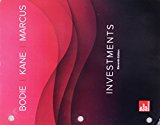
Concept explainers
To calculate: The increase in the inflation rate from 3% to 5% results in the fall of real rate of interest by using the Fisher equation.
Introduction: The interest rate which doesn’t consider any inflation is called as nominal interest rate while consideration of the inflation by the interest rate is called as real interest rate and this consideration reflects in the investment of the investor.
Answer to Problem 1PS
The fisher equation implies that the increment in the inflation rate from 3% to 5% can cause the fall of the real rate of the interest.
Explanation of Solution
Fisher equation is used to represent the relationship between the nominal interest rate, real interest rate and the inflation rate. This relation can be given as −
Where,
Given that, inflation rate is increasedform 3% to 5%. Then the increase in total inflation rate is 2%. As, there is no change in the real rate hence the nominal rate is increased by 2%.
Any change in the real rate of interest may result in the increment in the expected inflation rate. The situation of the increment in inflation rate results in the decrement of real rate is possible when the nominal rate is remaining constant while inflation rate is increasing. This kind of the situation is not very good situation.
Want to see more full solutions like this?
Chapter 5 Solutions
GEN COMBO LOOSELEAF INVESTMENTS; CONNECT ACCESS CARD
- Northern Escapes Inc. has 225,000 shares of stock outstanding. Each share is worth $73, so the company’s market value of equity is $16,425,000. Suppose the firm issues 30,000 new shares at the following prices: $73, $69, and $60. What will the effect be of each of these alternative offering prices on the existing price per share?arrow_forwardNeed answer correctly.arrow_forwardMuskoka Tourism has announced a rights offer to raise $30 million for a new magazine, titled ‘Discover Muskoka’. The magazine will review potential articles after the author pays a nonrefundable reviewing fee of $5,000 per page. The stock currently sells for $52 per share and there are 3.9 million shares outstanding.arrow_forward
- Ss stores probarrow_forwardHenrietta’s Pine Bakery Corporation would like to raise $75 million to finance its expansion into new markets. The company will sell new shares of equity via a general cash offering to raise the needed funds. If the offer price is $15 per share and the company’s underwriters charge a 6% spread, how many shares need to be sold?arrow_forwardNeed soln for this qnarrow_forward
 Pfin (with Mindtap, 1 Term Printed Access Card) (...FinanceISBN:9780357033609Author:Randall Billingsley, Lawrence J. Gitman, Michael D. JoehnkPublisher:Cengage Learning
Pfin (with Mindtap, 1 Term Printed Access Card) (...FinanceISBN:9780357033609Author:Randall Billingsley, Lawrence J. Gitman, Michael D. JoehnkPublisher:Cengage Learning Intermediate Financial Management (MindTap Course...FinanceISBN:9781337395083Author:Eugene F. Brigham, Phillip R. DavesPublisher:Cengage Learning
Intermediate Financial Management (MindTap Course...FinanceISBN:9781337395083Author:Eugene F. Brigham, Phillip R. DavesPublisher:Cengage Learning


